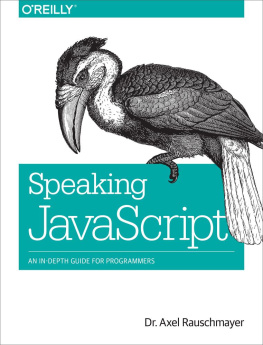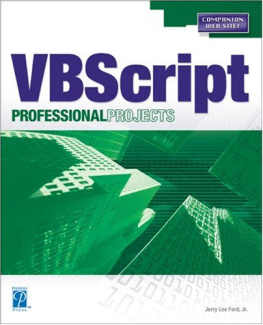
Free Videos and Webinars
Coming soon!
Mr. Jones plans to have free step-by-step demonstration videos walking people through concepts of QTP/UFT and/or Selenium from A - Z. The material will teach/train individuals the fundamentals of the programming language, fundamentals of QTP/UFT and/or Selenium, and advanced concepts of QTP/UFT and/or Selenium. All of the videos and webinars will be directed toward beginners as well as mid-level automation engineers.
Sign Up to Receive
- 3 Actionable Strategies
To Become A Master of QTP/UFT Within 30 Days
http://tinyurl.com/3-Tips-For-QTP-UFT
- 3 Actionable Strategies
To Become A Master of Selenium Within 30 Days
http://tinyurl.com/3-Tips-For-Selenium
Notification of free Videos and Webinars
http://tinyurl.com/Free-QTP-UFT-Selenium
Rex Jones Contact Information
Email Address:
LinkedIn: https://www.linkedin.com/in/rexjones34
Twitter: @RexJonesII
Skype: rex.jones34
Table of Contents
Preface
I must admit, it was a challenge writing this VBScript for QTP/UFT book. The challenge stems from an unlimited access to information on the internet. All of the information in this book can be found scattered throughout search engines, blogs, etc. However, if you are searching for one consolidated resource, then this is the book for you.
Target Audience
The target audience is beginners and mid-level automation engineers. Beginners are people new to QTP/UFT who need to learn more than the basics of VBScript. Mid-level automation engineers are people with knowledge of VBScript, but want to refresh their programming skills. No prior knowledge of VBScript or programming concepts is required. However, a common myth regarding QTP/UFT is that development skills are not necessary. The truth is development skills are very necessary.
Why learn VBScript?
Can you imagine traveling to a foreign country and trying to communicate with the native people without learning their language? That is similar to communicating with QTP/UFT without learning VBScript. The purpose of this book is to help automation engineers understand that QTP/UFT cannot be fully optimized without a strong foundation of VBScript. A mistake most QTP/UFT books and training courses make is not providing solid information on the VBScript programming language. These books and training courses focus solely on QTP/UFT, which leads to automation engineers struggling with automation projects. Automation is the future of testing applications. Take this opportunity to learn VBScript.
About the Author

Rex Allen Jones II is a QA/Software Tester with a passion for sharing knowledge about testing software. He has been watching webinars, attending seminars, and testing applications since February 2005. Mr. Jones graduated from DeVry University in June 1999 with a Bachelors of Science degree in Computer Information Systems (CIS).
Currently, Rex is a Consultant and on the Board of Directors for User Group: Dallas / Fort Worth Mercury User Group (DFWMUG) and an active member of User Group: Dallas / Fort Worth Quality Assurance Association (DFWQAA). In addition to his User Group memberships, he is a Certified Software Tester Engineer (CSTE) and has a Test Management Approach (TMap) certification.
Mr. Jones advice for people interested in Functional Automation Testing is to learn the programming language. This advice led him to write two books (Part 1 & Part 2) You Must Learn VBScript for QTP/UFT geared towards VBScript which is the programming language for Unified Functional Testing (UFT) formerly known as Quick Test Professional (QTP). In addition, two upcoming books geared toward Java which is one of the programming languages for Selenium.
About the Editor

When Samantha Mann is not improving the contents of a document through constructive editing marks and remarks, she is enjoying life as a professional in Dallas, Texas. Samantha is a User Experience guru in the realms of research and design, and works as an Information Technology consultant. Outside of work her hobbies include the typical nerd-type fun of freelance editing, reading, writing, and binge watching Netflix with her pitbull.
Connect with Samantha:
Samantha.danae.mann@gmail.com
https://www.linkedin.com/pub/samantha-mann/84/9b7/100
Copyright, Legal Notice, and Disclaimer
This publication is protected under the US Copyright Act of 1976. All rights are reserved including resale rights which applies to international, federal, state, and local laws. The purchaser is not allowed to share or sell this book to anyone.
Please note that much of this publication is based on personal experience and anecdotal evidence. The author has made every reasonable attempt to produce accurate content in this book. He assumes no responsibility for unknown errors or omissions. Therefore, the purchaser should use this information as he/she sees fit.
Any trademarks, service marks, product names or named features are assumed to be the property of their respective owners and used only for reference.
Copyright 2015 Test for Success. All rights reserved worldwide.
Acknowledgements
I would like to express my gratitude to my wife Tiffany, children Olivia Rexe and Rex III, family, friends, and the many people who provided encouragement. Writing this book took time and your support helped pushed this book forward.
Thank You,

Rex Allen Jones II
Chapter 1 Introduction to VBScript
Overview
VBScripts full name is Microsoft Visual Basic Scripting Edition language. It is a simplified version of the Visual Basic (VB) and Visual Basic for Applications (VBA) family of programming languages. VBScripts syntax is based on Visual Basics syntax. Syntax is a set of rules that determine how the language will be written and interpreted by the browser or server. Most of VBScripts features are taken from Visual Basic. Features, such as the control flows, operators, and procedures, are acceptable in the family of Visual Basic.
Visual Basic is the full-blown programming language, while VBScript is the scaled down version that supports scripts. Processing is the main difference between a full-blown programming language and a scripting language. A scripting language has to reprocess every time it is run, but a full-blown programming language runs faster because it is only processed one time.
VBScript is written for a runtime environment that can interpret and automate tasks. It uses the Component Object Model to access elements of the environment within which it is running. Software applications, web pages within a browser, the shells of an operating system (OS), and embedded systems are example environments that can be automated. VBScript can be used in the following instances:
Windows administrative tasks
HTML pages, as a client-side scripting language
Server-side scripting language, in native Application Service Provider (ASP) pages with Internet Information Services (IIS) web server
Embedded applications
Scripting language in Quick Test Professional (QTP)/Unified Functional Testing (UFT) for automation testing
Next page








